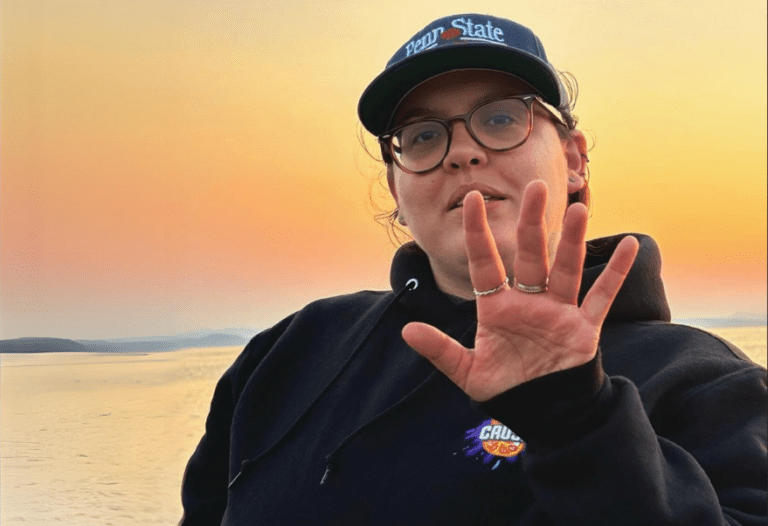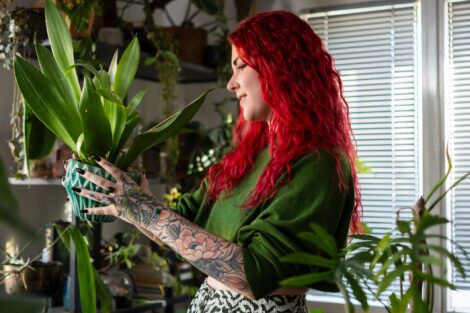- Blog
- Stories of Strength
- Article
Navigating the Borderline: One Woman's Ovarian Tumor Odyssey
September 16, 2024

At 26, Abbey Dufoe was living a life familiar to many young adults. She played ice hockey in an adult league, hiked on weekends, and frequently took trains into New York City for concerts. She was training hard for the upcoming hockey season while working 12-hour days at her office job. But beneath the surface of this busy life, an unseen threat was growing.
In 2018, she was diagnosed with borderline ovarian tumors (BOT), a condition that would challenge her in ways she never anticipated.
Early Warning Signs
It started in the summer of 2017. Abbey began experiencing various symptoms that didn’t add up. Abdominal pain, indigestion, and back pain plagued her daily life. Despite her athletic lifestyle, she was also gaining weight. At the time, Abbey chalked it up to her intense training schedule and long work hours.
These vague symptoms exemplify the challenges in diagnosing borderline ovarian tumors (BOTs). These rare growths, affecting only about 5 in 100,000 women annually, occupy a gray area between benign and malignant tumors. Unlike aggressive ovarian cancers, BOTs grow slowly and don’t invade surrounding tissues, making them notoriously difficult to detect.
Abbey’s journey through the medical system highlights this challenge. Her general practitioner suggested she “get a new job because (she) seemed stressed.” An allergist incorrectly attributed her symptoms to newly developed food allergies. At urgent care, a nurse practitioner pressed on her stomach and declared she “probably (had) gas,” sending her home with Gas-X. Even her yearly gynecological check-up revealed nothing unusual.
December 2017 brought an unexpected turn of events. Abbey recalls, “I threw my back out while sliding off a desk I was sitting on.”
This incident led to another visit to urgent care, resulting in a cortisone shot and the start of physical therapy. It also meant Abbey had to stop playing hockey and hiking, significantly altering her active lifestyle.
She had a more critical emergency in February 2018. Abbey woke up in the middle of the night with excruciating abdominal pain. In her words, “I tried to throw up, thinking it would quell the pain, but instead, I passed out and hit my head three times on the way down to the floor.”
She regained consciousness on a stretcher en route to the emergency room.
After a 12-hour wait, an ultrasound finally revealed the cause of Abbey’s suffering. “The wand was barely down on my stomach when the tech said, ‘Oh, you have a mass in your abdomen,'” Abbey remembers. A CT scan confirmed the presence of a mass on her ovary.
A Life-Changing Diagnosis
Following surgery to remove her right ovary and fallopian tube, Abbey received news that would reshape her life. She was diagnosed with borderline ovarian cancer, along with polycystic ovary syndrome (PCOS) and abnormal endometriosis. This combination of diagnoses thrust Abbey into a medical twilight zone.
 Unlike typical ovarian cancer patients, those with BOT (sometimes referred to as ovarian tumors of low malignant potential, or LMP) don’t usually require chemotherapy or radiation. Instead, they face years of surveillance and uncertainty. It’s this ambiguity that seeds the ground for what Abbey and many BOT patients experience: a profound sense of being caught between worlds.
Unlike typical ovarian cancer patients, those with BOT (sometimes referred to as ovarian tumors of low malignant potential, or LMP) don’t usually require chemotherapy or radiation. Instead, they face years of surveillance and uncertainty. It’s this ambiguity that seeds the ground for what Abbey and many BOT patients experience: a profound sense of being caught between worlds.
“You feel less than patients with Stage 4 cancer,” Abbey explains. “You sometimes don’t fit into these spaces.”
This sentiment crystallizes the unique psychological burden of BOT. Patients often grapple with a form of imposter syndrome, feeling out of place both in the world of the healthy and in cancer support communities.
Well-meaning but misguided comments from others compound this feeling. Abbey shares that people sometimes tell her, “Oh, your hair looks great,” even though she never underwent chemotherapy for ovarian cancer. Such remarks, while intended to be supportive, only highlight the disconnect between Abbey’s experience and the typical cancer narrative.
Living Scan to Scan
Now 33, Abbey’s life revolves around a cycle of check-ups and scans. She describes her situation as “wait and watch, or more accurately, wait and watch and slice me open.” This approach is standard for BOT patients, as the condition can recur years after initial treatment.
Indeed, Abbey has faced recurrences. In February 2020, two years after her initial diagnosis, another growth appeared on her remaining ovary, which was removed laparoscopically in December 2020. In October 2021, yet another growth was detected. And in March 2022, another.
The emotional toll is significant. Abbey feels she must live her life in chunks between scans. Some days, the “scanxiety” — anxiety related to medical scans — is so intense that she’s unable to do much. The imposter syndrome amplifies this anxiety, leading her to question the legitimacy of her own experiences and emotions.
Finding Support and Moving Forward
 Despite these challenges, Abbey has found ways to cope. She’s connected with online support groups, particularly queer support groups, where she doesn’t have to “come out” as gay or as a cancer survivor. In these spaces, she can be her full self without explanation.
Despite these challenges, Abbey has found ways to cope. She’s connected with online support groups, particularly queer support groups, where she doesn’t have to “come out” as gay or as a cancer survivor. In these spaces, she can be her full self without explanation.
Abbey has also prioritized her mental health. She participated in a Steps through OC program, working with an ovarian cancer counselor for 10 sessions. She started therapy and even obtained her yoga teacher certificate, all of which have helped her ground herself during turbulent times.
Her journey with BOT has transformed Abbey into a fierce advocate for herself and others. She emphasizes the importance of trusting one’s instincts and persisting when something feels wrong. She advises that you should advocate for yourself, even if it means seeing different doctors until someone listens to your concerns.
The Ongoing Battle
Abbey’s story underscores the critical need for more research and awareness about borderline ovarian tumors. The lack of understanding about this condition not only complicates diagnosis and treatment but also contributes to the emotional and psychological challenges faced by patients.
Organizations like Not These Ovaries are working to bridge this gap, funding research and supporting those with rare gynecological cancers like BOT.
As Abbey continues navigating life with BOT, she remains committed to sharing her story. Her experience illuminates the complexity of cancer diagnoses and the importance of recognizing the full spectrum of cancer experiences, including those that don’t fit the typical narrative.
In the realm of rare cancers, every story matters. Abbey’s journey with BOT challenges our understanding of what it means to be a cancer survivor. It’s a testament to the resilience of those living in the liminal spaces between illness and health, and a call for greater recognition of their unique struggles.
As research advances and awareness grows, there’s hope that future patients will face a clearer path: more accurate diagnoses, targeted treatments, and broader understanding from the medical community and society. For now, Abbey takes life one day at a time, one scan at a time, continually redefining what it means to be a survivor on her own terms.


